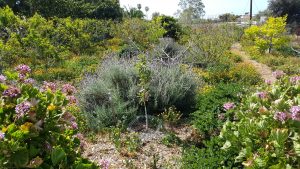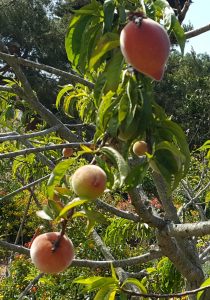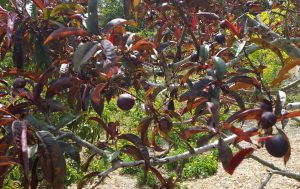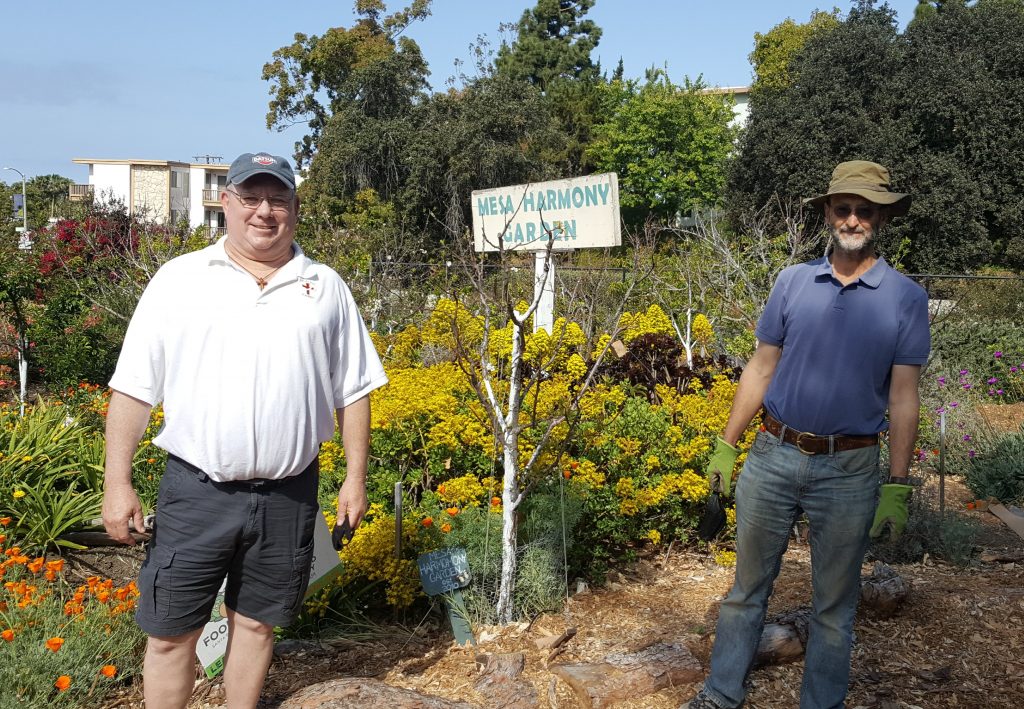What does agriculture have to do with being a Catholic deacon?
Think of it this way: planting, growing, nurturing, harvesting. Does that sound familiar?
When Deacon Randy Saake surveys the Mesa Harmony Garden that he started 11 years ago on vacant land behind Holy Cross Church in Santa Barbara, he sees more than the 115 fruit trees that produced 1,800 pounds of organic produce donated to local charities last year.
“This garden,” said Saake, “fulfills our vision: to teach others how and what to do, not just in growing food and sharing it with the community, but in working together to serve the greater good — feeding the hungry, caring for the environment, working in harmony for a common purpose.”
Smiling, he added, “There is a lot you can do in a small space.”

Indeed, Mesa Harmony Garden occupies barely three-fourths of an acre on the northwest end of Holy Cross’ property, down the slope from its parking lot. But its presence has become a fixture in southwest Santa Barbara’s Mesa neighborhood, sandwiched between Highway 101 and the Pacific Coast. And despite the global pandemic that struck in 2020, last year saw the garden’s largest yield of donated produce in its history.
“When we were getting started 10 years ago,” Saake said, “people would walk by this vacant space, see us trying to make a garden, and just shake their heads.”
“Now,” said Hugh Kelly, Mesa board president and among the first people to volunteer at the garden in 2010, “you’ll see more people working here just about any Saturday, and it’s become quite an attraction. Over the years, in fact, I’d say hundreds have volunteered here in one way or another.”
More than 800 people are on the garden’s email list “to stay aware of what we do,” he said. “And if we ever need volunteers for planting or harvesting, we get a great response. Weeding? Not so much,” he said.
Recently, pandemic protocols have limited the volunteer labor force to one gardener at a time (versus 12 to 15 in normal times), though with Santa Barbara County recently reaching the orange tier of California’s COVID-19 reopening system, that may change. But there is no limit to the enthusiasm with which Mesa’s supporters have embraced their “food forest” project.

Saake has put his background in construction to good use in improving the irrigation and water-capturing systems in the garden, including a “deep drip” system that measures precisely how much water is required without wasting any, “very important in dry times like this year.”
“This garden is a practical demonstration of permaculture and organic principles applied to urban food production,” he explained. “Growing more sustainable local food enhances food security, and helps build self-reliance and a resilient local community.”
Kelly, originally from the north of England, is a certified permaculture designer, a master gardener with the UC Cooperative Extension Service, and runs a pilot program to train and support farmers in East Africa to create sustainable livelihoods. For Mesa Harmony Garden, he oversees a group of lead volunteers who care for the garden.
“There is a three-dimensional aspect to this garden,” he said. “One, of course, is growing and raising food to feed the community. Second, it’s bringing the community together in civil and social volunteering to engage in a common purpose. And finally, it’s educating the community on what kind of landscaping can be done even in a small space.”
That includes educating them on a basic aspect of nature: growing takes time.
“People in today’s world often want instant gratification, but nature doesn’t work that way,” said Kelly. “To do this project is a long-term commitment, and you need to be prepared to sustain it long-term.”
The volunteer force includes Holy Cross parishioners, Santa Barbara City College students, Americorps and the Orfalea REACH program volunteers, and folks from the Mesa community who simply want to help. The work is supported by donations from community members and organizations to meet the costs of planting, watering, and maintenance.

In the beginning, in fact, Santa Barbara Foodbank, a principal beneficiary of the garden’s bounty, helped the garden grow by sharing a grant “so we could buy the first 70 trees,” said Saake, who envisioned this project as a ministry from the start.
“We had the vacant land, and I thought maybe we could plant something here and offer it to our neighbors,” he said. “But this,” he added, gesturing toward the blossoming orchards, “is far beyond my expectations. We were fortunate to meet people like Hugh who had ideas on what a sustainable food forest could be, and it’s evolved over the years.”
Certainly, the homegrown fruit — apples, peaches, plums, oranges, avocados, nectarines, pears, bananas, and multiple varieties of each — are appreciated by their recipients. But like the fish and loaves that fed the multitudes, they are a means to a greater end.
“The garden,” he said, “has become a meeting place for the community, where everyone is welcome, they get to know one another and they become more aware of their neighbors and their environment, and how they can serve residents in need.”
And that sounds like a good definition of “ministry.”

